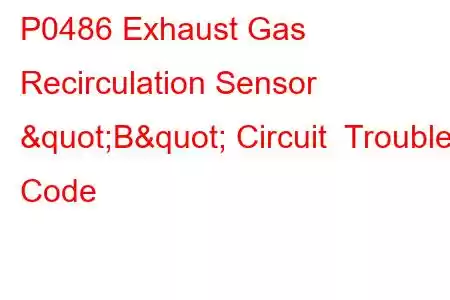P0486 Exhaust Gas Recirculation Sensor "B" Circuit
OBD-II Trouble Code Technical Description
Exhaust Gas Recirculation Sensor "B" Circuit
What does that mean?
This is a generic powertrain diagnostic trouble code (DTC), which means it covers all makes/models, 1996-newer. However, specific troubleshooting steps will vary depending on the vehicle.
On board diagnostics (OBD) trouble code P0486 is a generic trouble code relating to a problem incurred in the "B" electrical circuit to the exhaust gas recirculation (EGR) valve.
The purpose of the EGR valve is to introduce a regulated amount of exhaust gas into the intake manifold. The purpose is to maintain cylinder head temperatures below 2500-degrees F. Nitrates of Oxygen (Nox) form when temperatures rise above 2500-degrees F. Nox is responsible for smog and atmospheric pollution.
The controlling computer, either the powertrain control module (PCM) or the electronic control module (ECM) has detected an abnormally low, high or non-existent signal voltage.
EGR Operating Principals
The trouble code P0486 refers to the same problem on all vehicles, however, there are many types of EGRs, sensors and methods of activation. The only similarity is that they all vent exhaust gas into the intake manifold to cool the cylinder head temperatures.
Introducing spent exhaust gas into the engine at the wrong time reduces horsepower and causes a rough idle or stall. With this in mind, computer programming only opens the EGR when the engine RPM is above 2000 and to close when under a load.
Symptoms
The symptoms depend on the position of the EGR pintle at the time of failure.
The service engine soon light will illuminate and the OBD code P0486 will be set. Additionally, a second code relating to the EGR sensor failure may be set. Code P0405 relates to a low sensor voltage and P0406 relates to a high voltage situation If the EGR pintle is stuck partly open, the vehicle will not idle well or stalls Ping from detonation may be heard when under a load or at high RPM No symptoms at allPotential Causes
Defective EGR sensor "B" Defect in the wiring harness to the sensor EGR pintle stuck in the closed position and a build up of carbon is preventing it from opening Lack of vacuum to the EGR solenoid Defective EGR solenoid Defective EGR position sensor Defective differential pressure feedback EGR sensor.Repair Procedures
All EGR valves have one thing in common-they re-circulate exhaust from the exhaust to the intake manifold. Other than that, they differ in their methods for regulating the opening of the pintle and sensing its position.
The following repair procedures represent the most common problems accounting for the majority of failures in the EGR system. Wiring harness or sensor failures require a service manual to determine the proper wire identification and diagnostic procedures.
Keep in mind that the wiring differs between manufacturers and computers do not react well if the wrong wire is probed. If you probe the wrong wire and send excessive voltage through the computer's sensor input terminal and the computer will fry.
At the same time, if the wrong connector is disconnected the computer could lose its programming causing the vehicle to fail to start again until the dealer reprograms the computer.
The code P0486 indicates a "B" circuit malfunction, so check the EGR sensor connector for corrosion, bent or pushed out terminals or loose connection. Clean off any corrosion and re-seat the connector. Remove the electrical connector and remove the EGR. Check for coking in the EGRs intake and exhaust. Clean out any coking as necessary so the pintle will move up and down smoothly. Check the vacuum line from the EGR to the solenoid and replace it if any defects are found. Check the solenoid electrical conneRead: 44


